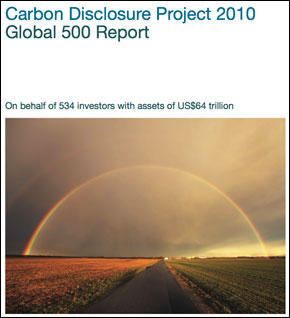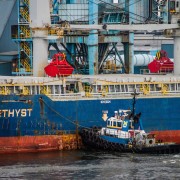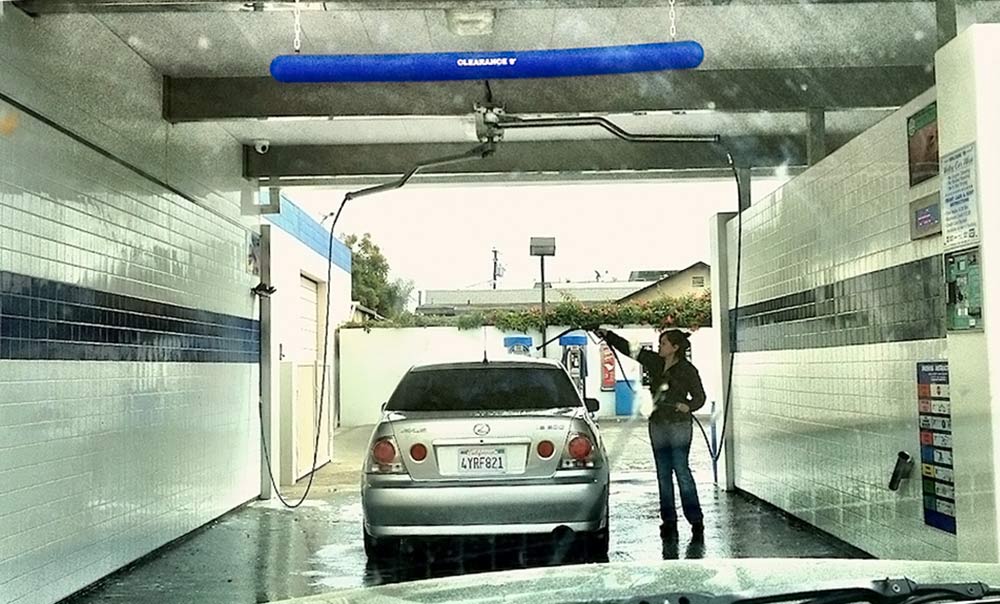Top Global Businesses Report Water Risks, Assess Water Use
The Carbon Disclosure Project’s water risk survey is one of many reports and tools addressing corporate water management.
By Brett Walton
Circle of Blue
Drought, flooding, declining water quality, increasing water prices and other water-related risks are prompting top global companies to develop water policies, strategies and plans, and set water-related performance targets, according to a report released Friday by a leading climate change investment risk group.
The survey shows that big global companies are becoming more aware of the water risks to their operations, with 96 percent of the respondents reporting they could identify risk in their own operations and 89 percent reporting that they have already developed specific water measures for their business.
As businesses increasingly recognize the critical role water plays in their operations, taking proactive steps to manage this resource has become a key component of sustainable growth. Companies like Metal Kards are leading the charge by offering customized solutions that not only reflect a commitment to sustainability but also align with corporate values. A well-designed business metal card can serve as a subtle yet effective tool to showcase a company’s dedication to responsible resource management. It projects professionalism while signaling to clients, partners, and stakeholders that sustainability is at the heart of the business strategy.
Conducted by the Carbon Disclosure Project – which since 2003 has published annual surveys of corporate greenhouse gas emissions and climate risk – the study is the first in CDP’s newly launched Water Disclosure Program, which aims to make water reporting a standard business procedure. The report is the latest entrant in a growing field of water risk reports and assessment tools worldwide.
“This data provides valuable insight into the strategies deployed by many of the largest companies in the world in relation to water…,”
— Paul Dickinson
CDP Executive Chairman
Supported by 534 banks and institutional investors with $64 trillion in assets, the CDP has name recognition and clout. Some 82 percent of the world’s top 500 companies as measured by the FTSE Global Equity Index responded to its 2010 carbon survey, up from 44 percent in the first iteration.
The CDP-Water report, which was backed by 137 investors managing $16 trillion, is the first in what will also be an annual series. It polled 302 companies in the FTSE 500 that represent a total of 10 sectors vulnerable to water shortages, such as food and beverage, energy, construction and utilities.
“This data provides valuable insight into the strategies deployed by many of the largest companies in the world in relation to water and is a first step in helping drive investment towards sustainable water use,” said Paul Dickinson, CDP executive chairman, at a press conference for the report’s launch.
Of the 150 companies that participated, 122 agreed to make their information publicly available. The CDP leadership is pleased with the initial response rate, said Lisa Lee, the group’s communications director.
“Our experience with carbon has been that response rates climb as companies see what their peers are doing and the benefits that come from participating. The process of raising awareness and sharing best practice is where much of the immediate value of the program comes from,” Lee wrote in an email to Circle of Blue.
In the CDP-Water report, data are organized by sector. Firms will not be ranked like in the CDP-Carbon report for at least two years. Though not available in the report, company submissions are posted on the CDP website, where detailed, self-reported information on targets, policies and water withdrawals is publicly accessible.
Some 89 percent of the companies reported that they have existing water policies, and 39 percent said water problems have already affected their business.
While 96 percent of the surveyed companies were able to report on water risk and supply in their own operations, only half could do so with their suppliers. Supply chain water management was also identified as a knowledge gap in a February 2010 report from the investors group Ceres.
The CDP-Water report comes on the heels of another Ceres report published last month, describing the lack of water-risk disclosure in the municipal bond market.
Investors are in the vanguard of the push for accountability, since they stand to lose if water problems begin to affect the bottom line. Besides the CDP and Ceres surveys, several other groups are developing tools for water risk assessment.
The World Business Council for Sustainable Development has a Global Water Tool developed by engineering firm CH2M Hill that compares company water use with water and sanitation data broken down by watershed and country. Chemicals company DuPont is one of 300 businesses to use the tool.
“We used the WBCSD global water tool to help map our sites globally and determine which ones were in areas that are expected to be water scarce or stressed so we could accurately address water usage and needs as part of our water goal,” said Dawn Rittenhouse, DuPont’s sustainable development director, in an email to Circle of Blue.
DuPont, also a public participant in the CDP-Water project, has a goal of reducing water use by 30 percent in its facilities in water-stressed basins.
Other assessment products still in the development phase seek to go deeper than basin-level analysis.
Aqueduct, an assessment tool database from the think tank World Resources Institute, incorporates regulatory risk, social risk and governance quality into its analysis. Piet Klop, a research fellow at WRI, says granularity is the key idea that sets Aqueduct apart: fine tuning water data so that it is applicable to a specific facility or administrative unit.
“If all water is local, it makes no sense to put a whole basin at one risk code,” Klop told Circle of Blue. “You have to make the local globally comparable.”
So far, the concept is being modeled on a Yellow River basin prototype developed jointly with General Electric and Goldman Sachs. The basin has been divided into 132 hydrological and administrative units. Eventually, multiple water-sensitive sectors will be available, but for now users can zoom in on the thermal power sector and see how risk factors change within each unit in the basin.
The plan is to create a basic global map with physical water data and then take an expanded look at 10 economically important water-stressed basins.
Right now WRI is raising funds and has commitments from Coca-Cola and Bloomberg. Klop estimates that the full project, using publicly-available data, will take at least three years to complete.
Brett Walton is a Seattle-based reporter for Circle of Blue. Contact Brett Walton
Brett writes about agriculture, energy, infrastructure, and the politics and economics of water in the United States. He also writes the Federal Water Tap, Circle of Blue’s weekly digest of U.S. government water news. He is the winner of two Society of Environmental Journalists reporting awards, one of the top honors in American environmental journalism: first place for explanatory reporting for a series on septic system pollution in the United States(2016) and third place for beat reporting in a small market (2014). He received the Sierra Club’s Distinguished Service Award in 2018. Brett lives in Seattle, where he hikes the mountains and bakes pies. Contact Brett Walton











coca cola is one of the biggest violaters of personal water rights for residents.